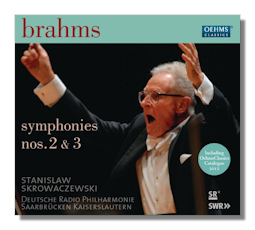
The Internet's Premier Classical Music Source
Related Links
- Brahms Reviews
- Latest Reviews
- More Reviews
-
By Composer
-
Collections
DVD & Blu-ray
Books
Concert Reviews
Articles/Interviews
Software
Audio
Search Amazon
Recommended Links
Site News
 CD Review
CD Review
Johannes Brahms

Symphonies, Volume 2
- Symphony #2 in D Major, Op. 73
- Symphony #3 in F Major, Op. 90
German Radio Philharmonic Saarbrucken Kaiserlautern/Stanislaw Skrowaczewski
Oehms OC409 86m 2CDs
One does not usually associate the Polish-born composer and conductor Stanislaw Skrowaczewski with the music of Brahms. Born in 1923, he is only now recording his first cycle of Brahms symphonies as far as I can determine, despite a fairly lengthy and varied discography. He has become well known for his interpretations of the symphonies of Bruckner and Beethoven and for works by Prokofiev and Shostakovich. On the evidence here, I'd say he has also established credentials as a very fine Brahmsian.
Skrowaczewski offers a lushly played, leisurely paced Brahms Second. In fact, regarding matters of tempo, it is among the most broadly paced Brahms Seconds I know of. Yet, it doesn't sound sluggish or overly slow in any way, but actually rather spirited, especially in the finale, which is the one movement that is pretty briskly paced. The first movement, at 20:49, might strike you as excessively broad, especially compared with performances like the Doráti on Mercury, which clocks in at a fleet 13:53!, a fast timing even accounting for its lack of the exposition repeat. But Skrowaczewski imparts a lyrical voluptuousness to the music, with Brahms' themes luxuriating in romantic warmth and tenderness, and you hear so much detail throughout the performance, not least because of the excellent sound reproduction provided by Oehms here and in the Third.
The first movement (Allegro non troppo) is among the most convincing renditions I've ever encountered, offering a mixture of that "warmth" and "spirit" in utterly splendid playing by the Deutsche Radio Philharmonie. Skrowaczewski makes everything sound natural here, as it does in the ensuing slow movement (Adagio non troppo). In Skrowaczewski's hand the character of the music in both these movements is mostly free of worry and anxiety, and quite unlike the darker take on the Brahms Second from John Eliot Gardiner on Soli Deo Gloria (Soli Deo Gloria 703), also an excellent but quite different version of this warhorse symphony.
Skrowaczewski's Brahms Third also features somewhat broad tempos, but is closer to a centrist approach in this respect. The first movement (Allegro con brio) is epic and sunny, though the development section, appropriately, features stormy intensity and a strong sense of angst. The Andante second movement sounds livelier here than its marking, but still unfolds as a lovely respite from the more driven, muscular character of the opening panel. The cantilena main theme of the third movement (Poco allegretto) has a pastoral flowing character here and is splendidly played by the orchestra. The Allegro finale begins in perhaps a more subdued manner than is customary, but it then springs to life, albeit with a good measure of angst. In fact, Skrowaczewski apparently sees this movement as darker than most conductors: the main material slashes away with weight and drive and even the alternate theme is a bit restive. In the end, however, Skrowaczewski brings on the peaceful close in a convincing mood of serenity.
One must assess both of these performances as excellent and fully competitive with the finest versions from conductors like Walter (Sony 64471), Wand (RCA and Profil), Böhm (DG), the aforementioned Gardiner, and others. A fine effort all around.
Copyright © 2013, Robert Cummings





















